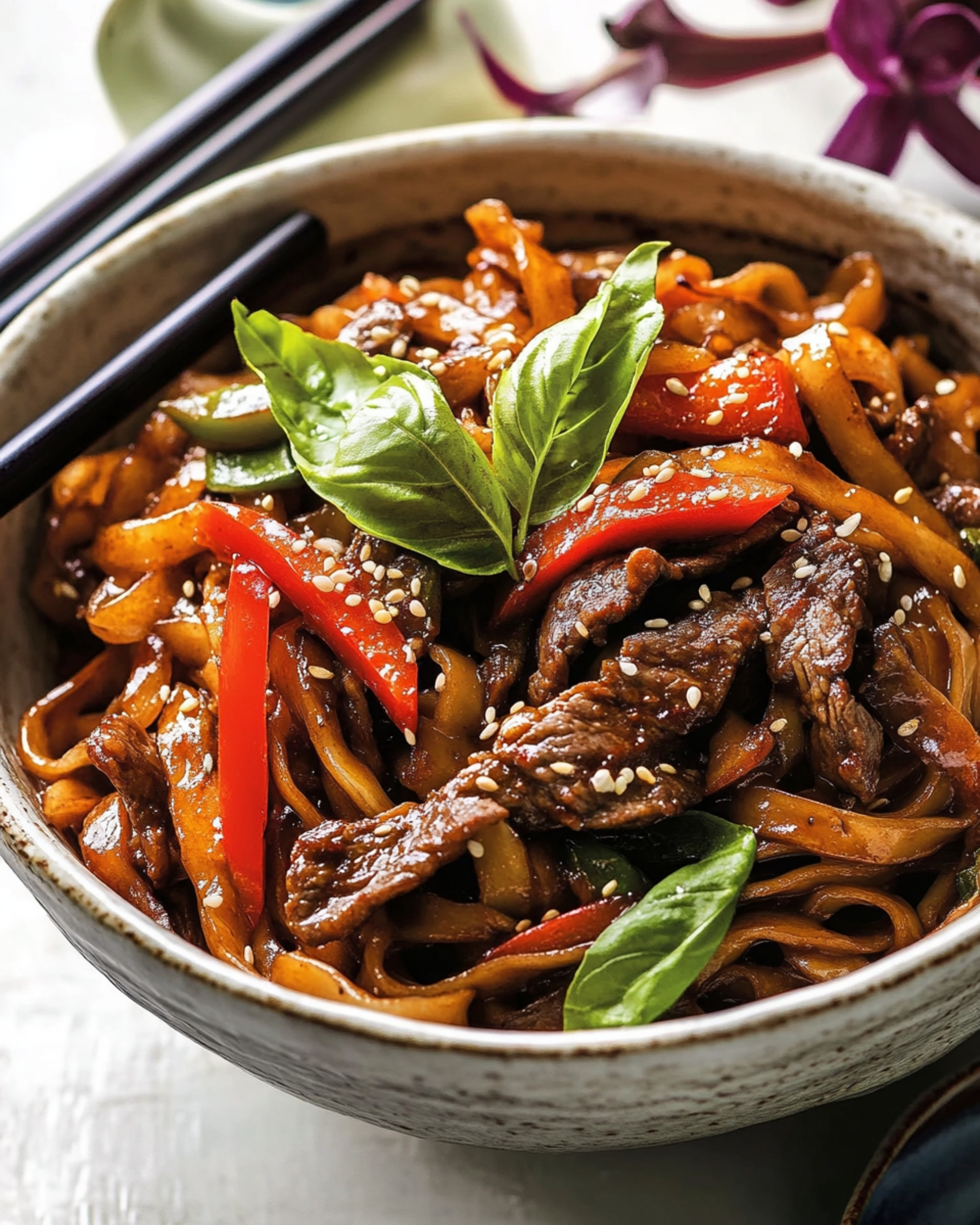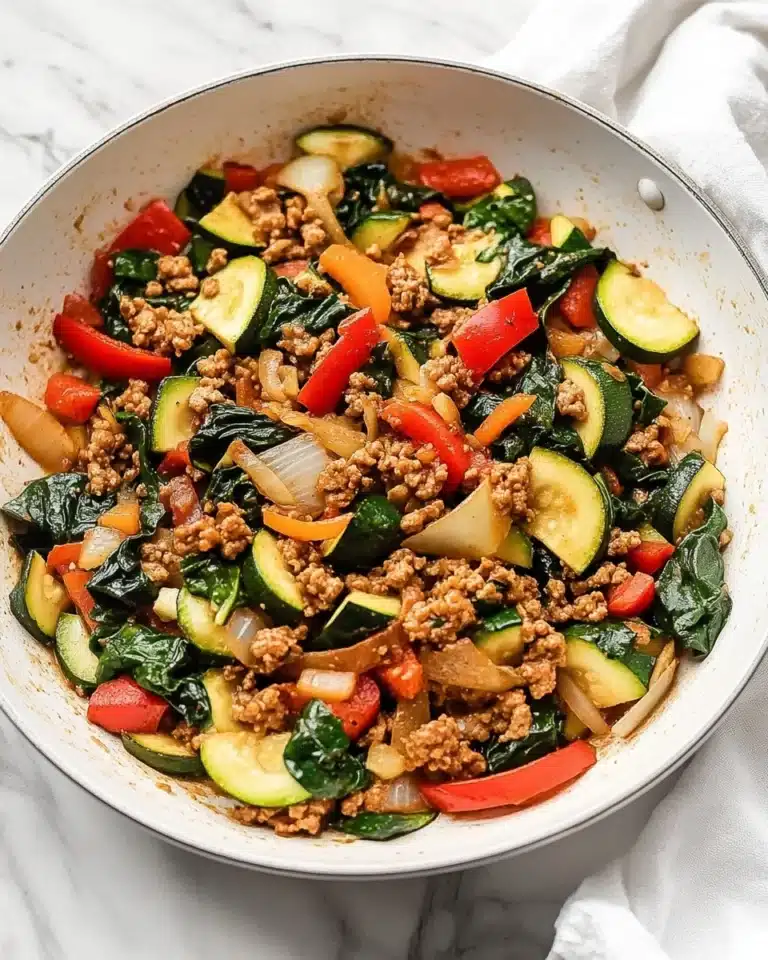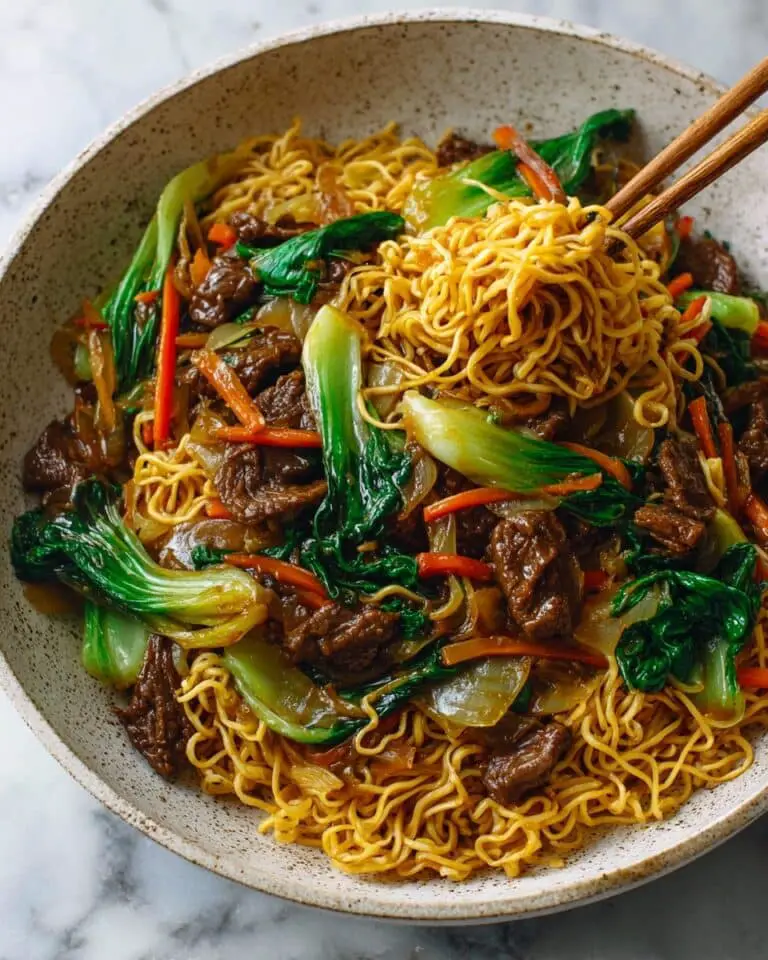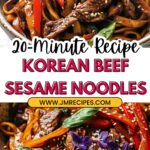This Korean Beef Sesame Noodles recipe is a game-changer for busy weeknights. Tender strips of flank steak and vegetables come together with chewy rice noodles in a sweet, spicy sauce that’s bursting with flavor. Ready in just 20 minutes, it delivers restaurant-quality taste with minimal effort. The combination of Gochujang, honey, and toasted sesame oil creates an irresistible umami-rich sauce that will have everyone asking for seconds!
Why You’ll Love This Recipe
- Super Fast: From start to finish in just 20 minutes, making it perfect for those hectic evenings when you need dinner on the table quickly.
- One-Pan Wonder: Most of the cooking happens in a single skillet, meaning less cleanup and more time to enjoy your evening.
- Flavor Explosion: The balance of sweet, savory, and spicy flavors creates a dish that’s incredibly satisfying without being complicated.
- Customizable: Easily adapt the heat level, protein choice, or vegetables based on what you have on hand or personal preferences.
Ingredients You’ll Need
For the Sauce:
- Garlic: Provides a punchy foundation that infuses the entire dish with savory depth.
- Fresh ginger: Adds a warm, zesty kick that’s essential for authentic Asian flavors.
- Tamari or soy sauce: The umami backbone of the sauce; tamari offers a deeper flavor if you have it.
- Honey: Balances the spice with natural sweetness while helping the sauce caramelize beautifully on the noodles.
- Rice vinegar: Adds brightness and cuts through the richness of the beef and sauce.
- Gochujang: This Korean chili paste brings complex sweet-spicy flavor that makes this dish special—don’t skip it!
- Toasted sesame oil: Provides that distinctive nutty flavor that defines Korean cooking.
For the Stir Fry:
- Brown rice noodles: Offer a nutty flavor and slightly chewier texture than white rice noodles, plus added nutrition.
- Sesame oil: For stir-frying; its high smoke point and flavor make it perfect for this dish.
- Mixed stir fry vegetables: Use whatever you have—bell peppers, snap peas, carrots, broccoli all work beautifully.
- Shallots: Milder than onions but with more complexity, these caramelize quickly and add sweetness.
- Flank steak: Thinly sliced for quick cooking; the marbling provides excellent flavor.
- Toasted sesame seeds: Add crunch and nutty flavor that complements the sesame oil.
- Fresh basil: Provides a surprising but delightful aromatic finish that lightens the dish.
Note: You’ll find the complete list of ingredients, along with their exact measurements, in the printable recipe card at the bottom of this post.
Variations
- Protein Swap: Replace beef with chicken breast, thinly sliced pork, shrimp, or even firm tofu for a vegetarian version.
- Noodle Options: Swap brown rice noodles for regular rice noodles, soba, udon, or even spaghetti in a pinch.
- Heat Level: Adjust the Gochujang amount to make it milder or spicier according to your preference.
- Veggie Mix: Try bok choy, mushrooms, snow peas, or spinach for different textures and flavors.
- Herb Alternatives: Thai basil or cilantro can replace regular basil if you prefer those flavors.
How to Make Korean Beef Sesame Noodles
Step 1: Prepare the Sauce
Combine garlic, ginger, tamari or soy sauce, honey, rice vinegar, Gochujang, and toasted sesame oil in a glass jar or bowl. Shake or whisk until thoroughly mixed. The sauce should be smooth with a rich reddish-brown color.
Step 2: Cook the Noodles
Cook the brown rice noodles according to package directions. Be careful not to overcook—they should retain a slight chew. Drain and rinse under cold water to stop the cooking process and prevent sticking.
Step 3: Stir-Fry the Vegetables
Heat 1 tablespoon of sesame oil in a large skillet over high heat. Add your mixed vegetables and cook until just wilted but still crisp, about 2-3 minutes. Add 2 tablespoons of the prepared sauce, toss to coat the vegetables, then remove from the pan.
Step 4: Cook the Beef
In the same skillet, add another tablespoon of sesame oil. Add the sliced shallots and cook for 2 minutes until softened and slightly caramelized. Add the thinly sliced flank steak in a single layer and let it sear undisturbed for 2 minutes to develop a nice crust. Toss the meat to cook the other side.
Step 5: Combine Everything
Pour the remaining sauce into the skillet with the beef and shallots. Let it simmer for 1 minute, then add the cooked noodles and vegetables back to the pan. Toss everything together and cook for 2-3 minutes until the sauce coats the noodles and thickens slightly.
Step 6: Finish and Serve
Remove from heat and stir in the fresh basil and toasted sesame seeds. Serve immediately, topped with additional fresh basil and sesame seeds if desired.
Pro Tips for Making the Recipe
- Prep First: Have all ingredients chopped, sliced, and ready before starting to cook. This stir-fry moves quickly!
- Slice Meat Properly: Cut flank steak against the grain and slice it very thin (partially freezing it first makes this easier).
- Don’t Overcook: The vegetables should remain crisp-tender, and the beef should be just cooked through to maintain tenderness.
- Heat Management: Keep your pan hot! A properly heated wok or skillet is crucial for stir-frying.
- Sauce Consistency: If the sauce seems too thick, add a splash of water or chicken broth. If it’s too thin, let it simmer a bit longer to reduce.
How to Serve
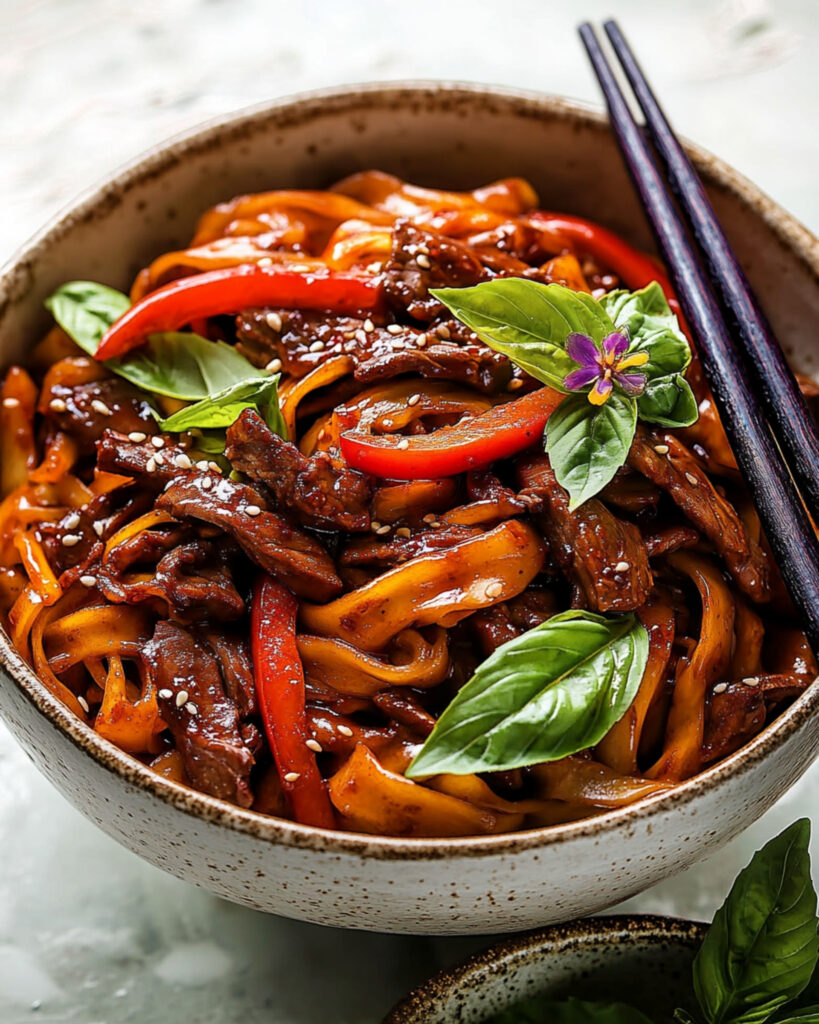
This Korean Beef Sesame Noodle dish is a complete meal on its own, but there are several ways to enhance your dining experience:
Perfect Pairings:
- Serve with kimchi on the side for an authentic Korean touch
- A simple cucumber salad dressed with rice vinegar provides a cool contrast
- Offer extra Gochujang or sriracha on the side for those who like it spicier
Beverage Suggestions:
- Cold Asian beer like Sapporo or Hite
- Unsweetened iced tea with a squeeze of lime
- A chilled glass of sake or soju for an authentic experience
Make Ahead and Storage
Storing Leftovers
Store any leftovers in an airtight container in the refrigerator for up to 3 days. The flavors often deepen overnight, making for an even more delicious lunch the next day.
Freezing
This dish doesn’t freeze well once fully assembled, as the noodles tend to become mushy when thawed. However, you can freeze the sauce separately in ice cube trays for quick flavor bombs in future meals.
Reheating
The best way to reheat this dish is in a skillet over medium heat with a splash of water to loosen the sauce. Microwave reheating works in a pinch—cover with a damp paper towel and heat in 30-second intervals, stirring between each.
For meal prep purposes, you can prepare the sauce and slice the meat up to 2 days ahead, storing them separately in the refrigerator.
FAQs
-
What is Gochujang and can I substitute it?
Gochujang is a Korean fermented red chili paste with a complex sweet-spicy flavor. While nothing perfectly replicates its taste, you can substitute with a mixture of sriracha and a bit of miso paste, or Thai chili paste with a touch of honey. The flavor profile will be different but still delicious.
-
Can I make this dish gluten-free?
Absolutely! Use tamari instead of soy sauce (verify it’s gluten-free), and ensure your Gochujang and rice noodles are certified gluten-free. Most ingredients in this recipe are naturally gluten-free, making it an easy adaptation.
-
How can I make this dish less spicy for kids?
Reduce the Gochujang to 1 tablespoon or less, and increase the honey slightly to balance the flavors. You can also serve the spicy sauce on the side for adults to add to their portions, keeping the base dish mild for children.
-
What’s the best cut of beef to use if I can’t find flank steak?
Skirt steak, sirloin, or ribeye are excellent alternatives. The key is to slice the meat very thinly against the grain. For an economical option, chuck steak can work well too—just make sure to trim excess fat and slice it extra thin.
Final Thoughts
This 20-Minute Korean Beef Sesame Noodles recipe proves that weeknight dinners don’t have to be boring or time-consuming. With its beautiful balance of sweet, savory, and spicy flavors, it delivers restaurant-quality taste with minimal effort. Whether you’re cooking for yourself or your family, this dish is sure to become a regular in your meal rotation. Give it a try tonight and discover your new go-to dinner when time is short but you still crave something special!
Print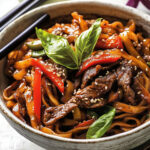
20 Minute Korean Beef Sesame Noodles Recipe
- Prep Time: 15 minutes
- Cook Time: 10 minutes
- Total Time: 25 minutes
- Yield: 4 servings
- Category: Main-course
- Method: Stovetop
- Cuisine: Korean
- Diet: Halal
Description
A quick and flavorful 20-minute recipe for Korean Beef Sesame Noodles that combines tender beef, stir-fried vegetables, and rice noodles tossed in a savory and mildly spicy sauce, finished with fresh basil and sesame seeds for a delicious and satisfying meal.
Ingredients
Sauce
- 4 cloves garlic, chopped
- 1 tbsp chopped fresh ginger
- 1/2 cup tamari or soy sauce
- 1/4 cup honey
- 2 tbsp rice vinegar
- 2 1/2 tbsp Gochujang (Korean chili paste)
- 1 tbsp toasted sesame oil
Stir Fry
- 8 oz brown rice noodles
- 2 tbsp sesame oil
- 3 cups mixed stir fry vegetables
- 3 shallots, sliced
- 1 lb flank steak or chicken breast, sliced thin
- 1/4 cup toasted sesame seeds
- 1/2 cup fresh basil
Instructions
- Make the sauce: Combine all the sauce ingredients (garlic, ginger, tamari/soy sauce, honey, rice vinegar, gochujang, and toasted sesame oil) in a glass jar. Shake or whisk thoroughly to mix.
- Cook the noodles: Prepare the brown rice noodles according to the package directions. Once cooked, drain and rinse them under cold water to prevent sticking.
- Stir-fry the vegetables: Heat 1 tablespoon of sesame oil in a large skillet over high heat. Add the mixed stir-fry vegetables and cook until they are wilted, about 2-3 minutes. Stir in 2 tablespoons of the prepared sauce, cooking until the sauce evenly coats the vegetables. Remove the vegetables from the skillet and set aside.
- Cook the beef/chicken: In the same skillet, add the remaining 1 tablespoon of sesame oil. Add the sliced shallots and cook for 2 minutes, until they are deeply softened. Add the sliced beef or chicken and spread it out in the pan without stirring, allowing it to sear for about 2 minutes. Toss the meat, then pour in the remaining sauce. Simmer for 1 minute.
- Combine and finish: Stir the cooked noodles and stir-fried vegetables back into the skillet with the beef/chicken and sauce. Cook for another 2-3 minutes, allowing the sauce to coat the noodles evenly. Remove the skillet from the heat and stir in the fresh basil and toasted sesame seeds.
- Serve: Transfer the noodles to serving plates and garnish with additional fresh basil, if desired. Enjoy!
Notes
- For a spicier dish, add more Gochujang or a pinch of red pepper flakes.
- This recipe works equally well with chicken or tofu as an alternative to beef.
- Feel free to customize the mixed stir-fry vegetables with your favorites, such as broccoli, bell peppers, or snap peas.
- Leftovers can be stored in an airtight container in the refrigerator for up to 3 days and reheated before serving.
Nutrition
- Serving Size: 1 serving
- Calories: 450
- Sugar: 12g
- Sodium: 1150mg
- Fat: 15g
- Saturated Fat: 3g
- Unsaturated Fat: 11g
- Trans Fat: 0g
- Carbohydrates: 55g
- Fiber: 4g
- Protein: 25g
- Cholesterol: 55mg

